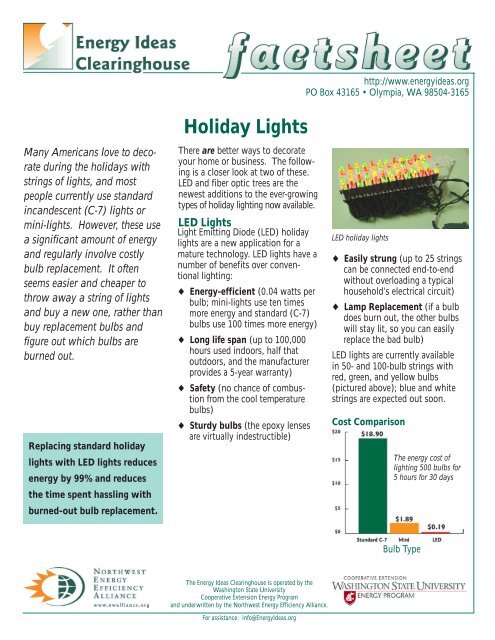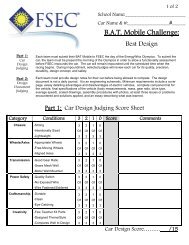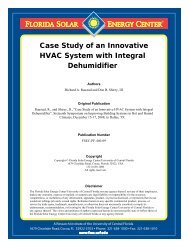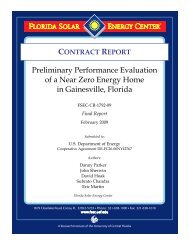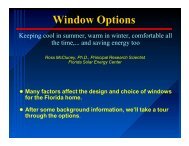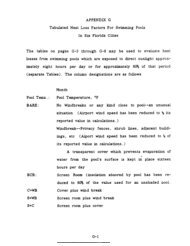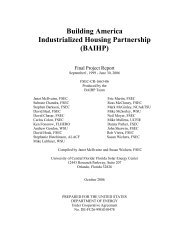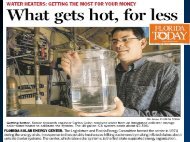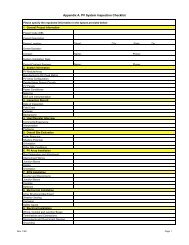Holiday Lights Factsheet
Holiday Lights Factsheet
Holiday Lights Factsheet
You also want an ePaper? Increase the reach of your titles
YUMPU automatically turns print PDFs into web optimized ePapers that Google loves.
Many Americans love to decorate<br />
during the holidays with<br />
strings of lights, and most<br />
people currently use standard<br />
incandescent (C-7) lights or<br />
mini-lights. However, these use<br />
a significant amount of energy<br />
and regularly involve costly<br />
bulb replacement. It often<br />
seems easier and cheaper to<br />
throw away a string of lights<br />
and buy a new one, rather than<br />
buy replacement bulbs and<br />
figure out which bulbs are<br />
burned out.<br />
Replacing standard holiday<br />
lights with LED lights reduces<br />
energy by 99% and reduces<br />
the time spent hassling with<br />
burned-out bulb replacement.<br />
<strong>Holiday</strong> <strong>Lights</strong><br />
There are better ways to decorate<br />
your home or business. The following<br />
is a closer look at two of these.<br />
LED and fiber optic trees are the<br />
newest additions to the ever-growing<br />
types of holiday lighting now available.<br />
LED <strong>Lights</strong><br />
Light Emitting Diode (LED) holiday<br />
lights are a new application for a<br />
mature technology. LED lights have a<br />
number of benefits over conventional<br />
lighting:<br />
♦ Energy-efficient (0.04 watts per<br />
bulb; mini-lights use ten times<br />
more energy and standard (C-7)<br />
bulbs use 100 times more energy)<br />
♦ Long life span (up to 100,000<br />
hours used indoors, half that<br />
outdoors, and the manufacturer<br />
provides a 5-year warranty)<br />
♦ Safety (no chance of combustion<br />
from the cool temperature<br />
bulbs)<br />
♦ Sturdy bulbs (the epoxy lenses<br />
are virtually indestructible)<br />
The Energy Ideas Clearinghouse is operated by the<br />
Washington State University<br />
Cooperative Extension Energy Program<br />
and underwritten by the Northwest Energy Efficiency Alliance.<br />
For assistance: info@EnergyIdeas.org<br />
http://www.energyideas.org<br />
PO Box 43165 • Olympia, WA 98504-3165<br />
LED holiday lights<br />
♦ Easily strung (up to 25 strings<br />
can be connected end-to-end<br />
without overloading a typical<br />
household’s electrical circuit)<br />
♦ Lamp Replacement (if a bulb<br />
does burn out, the other bulbs<br />
will stay lit, so you can easily<br />
replace the bad bulb)<br />
LED lights are currently available<br />
in 50- and 100-bulb strings with<br />
red, green, and yellow bulbs<br />
(pictured above); blue and white<br />
strings are expected out soon.<br />
Cost Comparison<br />
The energy cost of<br />
lighting 500 bulbs for<br />
5 hours for 30 days<br />
Bulb Type
Fiber Optic Artificial Trees<br />
A new product for consumers is the<br />
fiber optic artificial tree that have<br />
fiber optics built in. These trees use<br />
a low-wattage incandescent bulb<br />
ranging from 5 to 20 watts, depending<br />
on the size of the tree. Light is<br />
transmitted from a<br />
single bulb (so<br />
there’s only one<br />
bulb to replace)<br />
through hundreds<br />
of very small fibers<br />
and emitted along<br />
each branch of the<br />
tree. Some trees<br />
come equipped with a rotating color<br />
wheel that changes the color emitted<br />
from the fibers.<br />
Fiber optic lights are cool to the<br />
touch, as only light is transmitted<br />
from the fiber and not heat. The<br />
incandescent light source is located<br />
in the base of the tree with ventilating<br />
holes that must not be covered.<br />
The cost for such trees ranges from<br />
$20 for a 2-3-foot tree to over $200<br />
for the largest trees. Fiber optics are<br />
also now used in decorations such as<br />
Santa or Angel figures.<br />
Fiber Optic Tree<br />
Close up of fiber optics<br />
Conclusion<br />
Even though the five-year cost of<br />
LEDs is more than that of minilights,<br />
there are several good reasons<br />
to purchase LED lights anyway.<br />
These include avoiding the hassle<br />
and cost of replacing burned-out<br />
bulbs, supporting a new technology<br />
that uses much less energy, and<br />
avoiding adding more plastic to the<br />
landfill each year. If you want to<br />
purchase an artificial tree, you<br />
would do well to consider purchasing<br />
a fiber optic model. If you are<br />
considering other holiday lighting<br />
options, consider both purchase and<br />
energy costs.<br />
<strong>Holiday</strong> Lighting Costs<br />
Light Type Purchase Cost Energy Use (W) Total 5-yr Cost<br />
Standard C-7 $55 500 $134<br />
Mini <strong>Lights</strong> $9 120 $24<br />
LED <strong>Lights</strong> $30 12 $31<br />
Fiber Optic <strong>Lights</strong>* n/a 20 $1<br />
Assumptions:<br />
♦ Because standard incandescent bulbs are much larger and brighter, fewer are needed for a<br />
display. This table assumes an 8-foot tree with three 100-bulb strings of mini or LED lights,<br />
or five 25-bulb strings of C-7 lights. More lights are typically used in outdoor displays.<br />
♦ 6.3 cents per kWh.<br />
♦ Prices and quality vary widely among holiday lighting products, especially for mini-lights.<br />
The prices shown above and the assumed replacement period of 2.5 years for mini- and C-7<br />
lights represent the experience of the authors with holiday lighting products sold in this<br />
area. The purchase costs shown above are the number of strings assumed rather than for a<br />
single string.<br />
♦ Lighting is operated 5 hours/day, 30 days per year.<br />
* Cost shown for fiber optic lights is for energy use only, since the cost of lighting and tree<br />
cannot be separated.<br />
Retail Sources<br />
Albertsons<br />
Rite Aid<br />
True Value Hardware<br />
Ace Hardware<br />
Some retail establishments<br />
carrying Fiber Optic Trees:<br />
K Mart<br />
Wal-Mart<br />
Target<br />
Ace Hardware<br />
True Value Hardware<br />
Lowe’s<br />
Coast-to Coast Hardware<br />
and many on-line companies<br />
Additional Information<br />
http://www.foreverbright.com/<br />
http://www.ccl-light.com/main.shtml<br />
http://www.cityofseattle.net/light/<br />
conserve<br />
http://www.spectaculartree.com/<br />
index.html<br />
More information on energy efficient<br />
lighting is available from the Energy<br />
Ideas Clearinghouse,<br />
www.EnergyIdeas.org and the<br />
Lighting Design Lab,<br />
www.lightingdesignlab.com.<br />
© 2001 Washington State University Cooperative<br />
Extension Energy Program. This publication contains<br />
material written and produced for public distribution.<br />
You may reprint this written material, provided you do<br />
not use it to endorse a commercial product. Please<br />
reference by title and credit Washington State University<br />
Cooperative Extension Energy Program and the<br />
Northwest Energy Efficiency Alliance.<br />
WSUCEEP01_090<br />
Fall 2001<br />
Energy Ideas Clearinghouse


